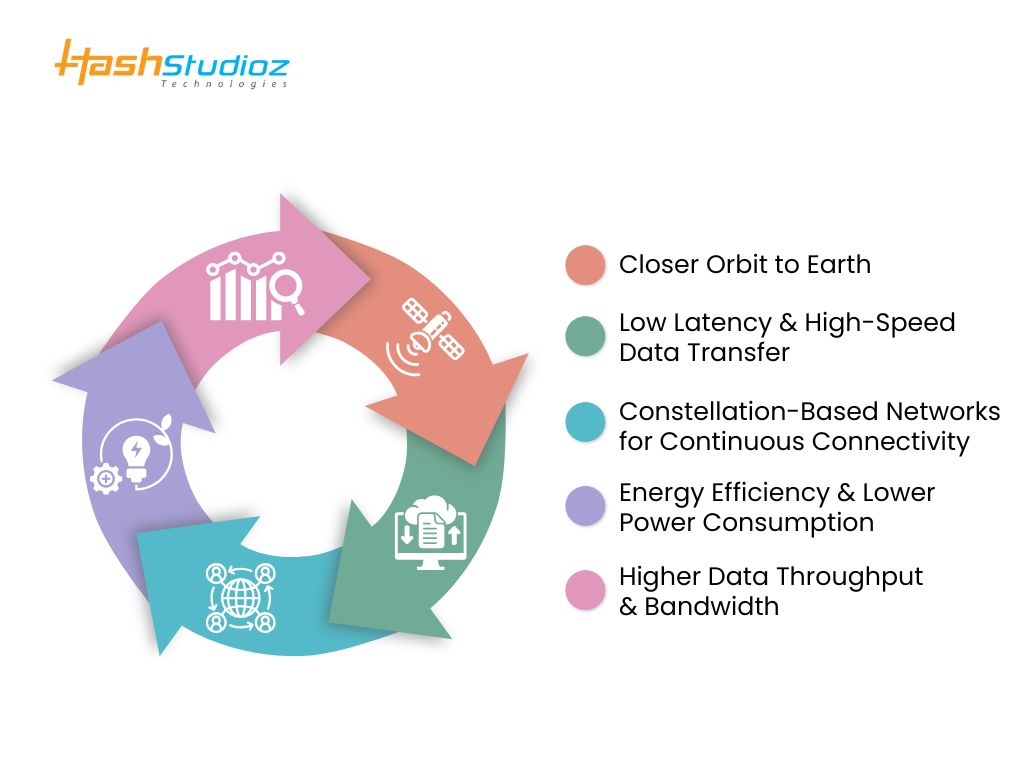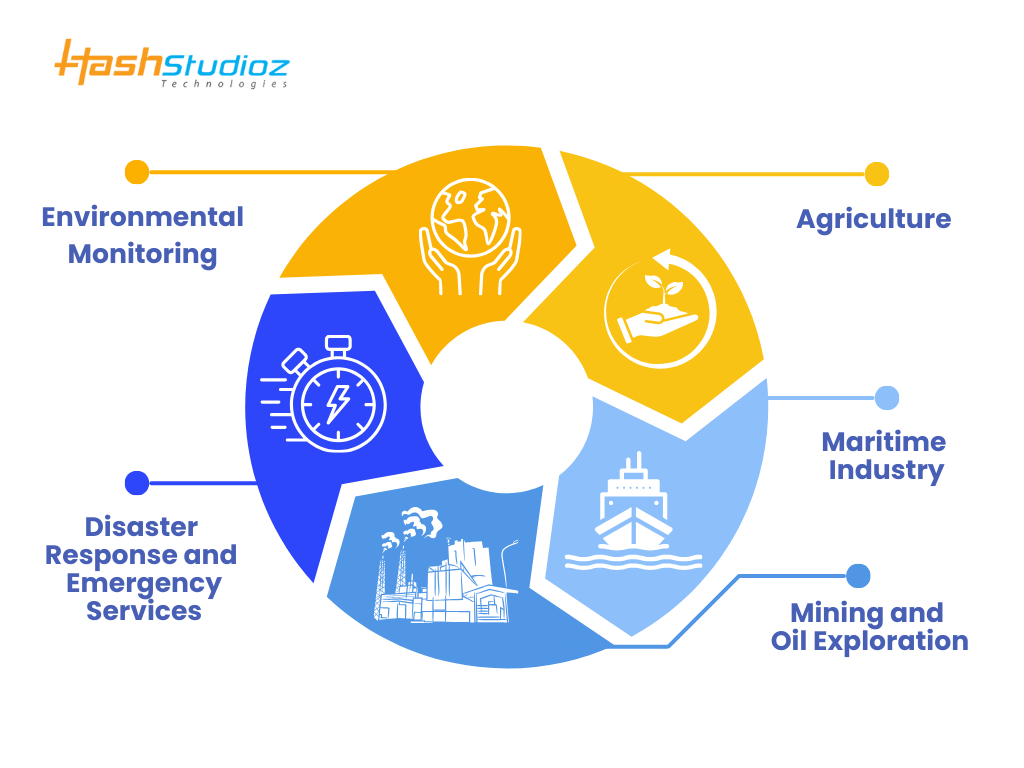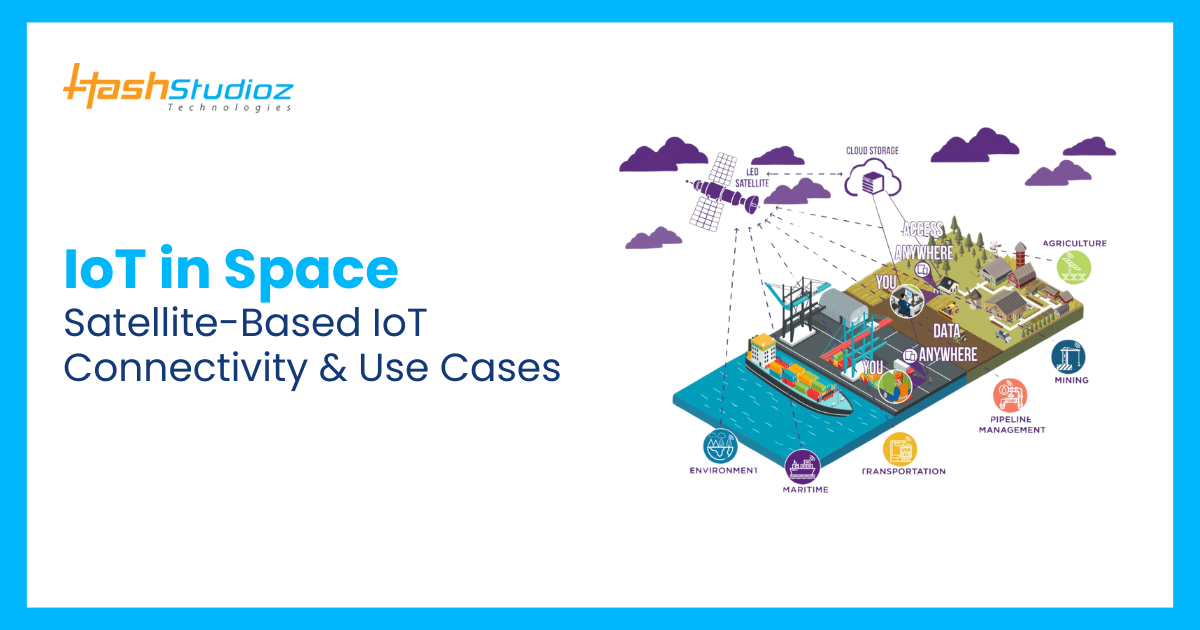The Internet of Things (IoT) has revolutionized industries by enabling seamless connectivity between devices, sensors, and applications. However, traditional IoT networks rely heavily on terrestrial connectivity, which often struggles to provide coverage in remote or inaccessible areas. This is where Satellite IoT comes into play, offering a robust solution for global IoT connectivity by extending coverage beyond terrestrial limitations.
From agriculture and maritime to mining and disaster response, satellite-based IoT is transforming industries by enabling real-time monitoring, predictive analytics, and automation in remote locations. With advancements in Low Earth Orbit (LEO) satellites, the future of IoT in space is poised to bring unprecedented opportunities for businesses, governments, and researchers.
- The global Satellite IoT market is projected to grow to $17.6 billion by 2027.
- Over 400 million IoT devices are expected to be connected via satellite by 2030.
- LEO satellite networks are set to provide 90% global IoT coverage by 2026.
Table of Contents
- Understanding Satellite IoT
- The Role of Low Earth Orbit (LEO) Satellites in IoT
- Benefits of LEO Satellites for IoT in Space
- Key Applications of Satellite IoT
- Challenges in Implementing Satellite IoT
- Technological Advancements in Satellite IoT
- The Future of Satellite IoT and Global IoT Connectivity
- 1. Expansion into Deep Space IoT
- 2. Growth of IoT in Space for Space Exploration
- 3. AI and Edge Computing Integration in Satellite IoT
- 4. Hybrid IoT Networks Combining Terrestrial and Satellite Connectivity
- 5. Quantum Encryption for Secure IoT Communications
- 6. Miniaturization and Cost Reduction of Satellite IoT
- 7. Integration of IoT in Smart Cities and Global Infrastructure
- 8. Universal Internet Access Through Satellite IoT
- Why Choose an IoT App Development Company for Satellite IoT Solutions?
- How an IoT Development Company Enhances Global IoT Connectivity
- Conclusion
- FAQs
Understanding Satellite IoT
What is Satellite IoT?
Satellite IoT refers to the integration of IoT devices with satellite networks to enable data communication over vast geographical areas, including remote, rural, and even extraterrestrial environments. Unlike traditional IoT networks that depend on cellular, Wi-Fi, or LPWAN (Low Power Wide Area Network), Satellite IoT ensures connectivity where terrestrial infrastructure is either unavailable or unreliable.
How It Differs from Terrestrial IoT
- Global Coverage: Satellite IoT extends connectivity to remote areas—oceans, deserts, mountains, and polar regions—where terrestrial networks are unavailable. This makes it ideal for maritime, aviation, and remote industrial operations.
- Lower Latency with LEO Satellites: Unlike traditional geostationary satellites at 35,786 km, Low Earth Orbit (LEO) satellites operate at 500-2,000 km, significantly reducing signal delay and improving real-time data transmission for critical IoT applications.
- More Reliable in Remote Locations: While terrestrial networks can suffer from infrastructure failures, natural disasters, or geographical barriers, Satellite IoT provides continuous, uninterrupted connectivity, ensuring smooth operations in mining, maritime navigation, and emergency response.
- No Dependence on Terrestrial Infrastructure: Cellular IoT relies on towers, fiber-optic cables, and Wi-Fi hotspots, which are limited in reach. Satellite IoT operates independently, ensuring communication even during network outages or disasters.
- Scalability for Global IoT Connectivity: Businesses and industries can scale IoT operations worldwide without needing to expand ground infrastructure, reducing deployment costs and accelerating connectivity in remote areas and even space exploration.
The Role of Low Earth Orbit (LEO) Satellites in IoT

1. Closer Orbit to Earth
- LEO satellites orbit at 500-2,000 km, significantly closer than geostationary satellites.
- This results in faster signal transmission, improving real-time communication for IoT devices.
2. Low Latency & High-Speed Data Transfer
- Due to their proximity to Earth, LEO satellites provide low-latency communication, often as low as 20-50 milliseconds, compared to 600+ milliseconds for geostationary satellites.
- This makes them suitable for real-time IoT applications, such as autonomous vehicles, remote healthcare, smart grid management, and industrial automation.
3. Constellation-Based Networks for Continuous Connectivity
- LEO satellites operate in constellations—large networks of interconnected satellites working together.
- Companies like Starlink (SpaceX), OneWeb, and Amazon’s Project Kuiper are deploying LEO satellite constellations to provide seamless IoT connectivity worldwide.
- These constellations ensure minimal downtime, as multiple satellites are available to relay data even if one moves out of range.
4. Energy Efficiency & Lower Power Consumption
- LEO satellites require less power for transmission compared to geostationary satellites, making them more energy-efficient.
- IoT devices using LEO satellites can operate longer on battery power, reducing maintenance and operational costs.
- This is especially beneficial for remote IoT applications, such as environmental monitoring sensors and smart agriculture devices.
5. Higher Data Throughput & Bandwidth
- LEO satellite networks provide higher bandwidth, allowing for faster data transfer rates.
- This enhances IoT applications that require high volumes of data processing, such as video surveillance, AI-powered analytics, and industrial IoT.
- Industries relying on real-time analytics—like logistics, precision farming, and connected transportation—benefit from higher data throughput.
Benefits of LEO Satellites for IoT in Space
1. Enhanced Global IoT Connectivity
- Seamless communication across oceans, deserts, mountains, and polar regions, where terrestrial networks are non-existent.
- Enables uninterrupted connectivity for industries operating in remote locations, such as offshore oil rigs, Arctic research stations, and deep-sea fishing vessels.
2. Scalability for Large-Scale IoT Deployments
- LEO-based IoT networks allow millions of IoT devices to communicate efficiently across different regions and industries.
- Businesses can expand operations globally without relying on traditional network infrastructure.
- Ideal for supply chain tracking, smart agriculture, and industrial IoT, requiring massive, distributed sensor networks.
3. Cost-Effective IoT Solutions
- The miniaturization of satellite technology has significantly reduced launch and operational costs.
- LEO satellites require less power for communication, lowering IoT device energy consumption.
- Companies can now deploy cost-effective IoT solutions in remote areas without investing in expensive terrestrial infrastructure.
4. Improved Disaster Response & Emergency Communication
- LEO satellites ensure uninterrupted communication during natural disasters, infrastructure failures, and emergencies.
- Essential for disaster relief teams, emergency responders, and humanitarian missions in areas where cellular networks are down.
- Facilitates faster coordination of rescue operations, medical aid, and crisis management.
5. Support for Space-Based IoT Applications
- LEO satellites are paving the way for IoT connectivity beyond Earth, supporting space missions and deep-space exploration.
- Enables real-time data transfer for spacecraft, space stations, and satellite constellations managing orbital assets.
- Facilitates space-based agriculture, asteroid mining, and interplanetary communication, laying the foundation for future extraterrestrial IoT networks.
Key Applications of Satellite IoT

1. Agriculture
- Precision Farming: Real-time monitoring of soil moisture, weather conditions, and crop health to enhance yield.
- Livestock Tracking: GPS-enabled IoT sensors monitor cattle movement and health in remote pastures.
- Irrigation Management: Automated water distribution systems use satellite-fed data analytics to optimize water usage.
2. Maritime Industry
- Fleet Management: Ships and vessels track their real-time location, even in remote oceanic areas.
- Environmental Monitoring: Detects oil spills, weather anomalies, and sea level variations for maritime safety.
- Cargo Security: IoT-enabled sensors ensure temperature-sensitive goods remain within optimal conditions during transit.
3. Mining and Oil Exploration
- Remote Equipment Monitoring: IoT devices track machinery performance in hazardous and remote sites.
- Worker Safety: Wearable IoT sensors monitor hazardous gas exposure, preventing workplace accidents.
- Environmental Compliance: Satellite IoT helps industries adhere to environmental regulations by tracking emissions and land use.
4. Disaster Response and Emergency Services
- Real-Time Communication: Ensures uninterrupted connectivity during disasters when terrestrial networks fail.
- Search and Rescue Operations: IoT sensors assist in locating trapped individuals in earthquake or flood-stricken areas.
- Wildfire and Flood Detection: Satellite-based IoT systems provide early warnings for natural disasters.
5. Environmental Monitoring
- Climate Change Tracking: IoT sensors gather data on temperature changes, CO2 levels, and glacier melting.
- Wildlife Conservation: GPS-enabled IoT collars help track and protect endangered species in remote regions.
- Deforestation Control: Satellite IoT detects and monitors illegal logging in forests worldwide.
Challenges in Implementing Satellite IoT
1. Latency and Bandwidth Limitations
- Even with Low Earth Orbit (LEO) satellites, latency remains a concern for ultra-low-latency applications like autonomous vehicles and real-time industrial automation.
- Limited bandwidth restricts large-scale data transmission, making it challenging for high-data IoT applications like video surveillance and remote sensing.
2. Cost and Infrastructure Constraints
- High initial investment required for satellite deployment, maintenance, and ground stations.
- Specialized IoT devices with satellite communication capabilities are needed, increasing operational costs for businesses.
3. Security and Data Privacy Issues
- Vulnerability to cyberattacks and data breaches due to the open nature of satellite communication.
- End-to-end encryption and advanced cybersecurity protocols are required to protect transmitted data from interception.
4. Power Consumption and Device Limitations
- Satellite-connected IoT devices require higher power consumption than terrestrial IoT devices, limiting their battery life.
- Developing energy-efficient IoT sensors that can sustain long-term operations in remote locations is a challenge.
5. Regulatory and Compliance Challenges
- International regulations for satellite communication vary, leading to complex licensing and compliance requirements across different countries.
- Ensuring spectrum availability and interference management is essential to avoid conflicts with other communication networks.
Technological Advancements in Satellite IoT

1. Latency and Bandwidth Limitations
- Even with Low Earth Orbit (LEO) satellites, latency remains a concern for ultra-low-latency applications like autonomous vehicles and real-time industrial automation.
- Limited bandwidth restricts large-scale data transmission, making it challenging for high-data IoT applications like video surveillance and remote sensing.
2. Cost and Infrastructure Constraints
- High initial investment required for satellite deployment, maintenance, and ground stations.
- Specialized IoT devices with satellite communication capabilities are needed, increasing operational costs for businesses.
3. Security and Data Privacy Issues
- Vulnerability to cyberattacks and data breaches due to the open nature of satellite communication.
- End-to-end encryption and advanced cybersecurity protocols are required to protect transmitted data from interception.
4. Power Consumption and Device Limitations
- Satellite-connected IoT devices require higher power consumption than terrestrial IoT devices, limiting their battery life.
- Developing energy-efficient IoT sensors that can sustain long-term operations in remote locations is a challenge.
5. Regulatory and Compliance Challenges
- International regulations for satellite communication vary, leading to complex licensing and compliance requirements across different countries.
- Ensuring spectrum availability and interference management is essential to avoid conflicts with other communication networks.
6. Scalability and Network Management
- Managing thousands of IoT devices across different locations poses challenges in data routing and load balancing.
- Satellite congestion can occur as more industries adopt global IoT connectivity, requiring efficient network traffic management.
7. Harsh Space Environment and Maintenance Issues
- Satellites operate in extreme conditions, facing risks from solar radiation, space debris, and temperature fluctuations.
- Repairing or upgrading satellites in orbit is difficult and expensive, requiring long-term durability planning.
The Future of Satellite IoT and Global IoT Connectivity
1. Expansion into Deep Space IoT
- NASA and private space companies like SpaceX and Blue Origin are exploring IoT for Mars missions and lunar exploration.
- IoT sensors could monitor asteroid mining operations, providing real-time data on resource availability and extraction processes.
2. Growth of IoT in Space for Space Exploration
- Spacecraft health monitoring: IoT-enabled sensors track system performance, fuel levels, and critical components.
- Real-time astronaut biometric tracking: Wearable IoT devices monitor astronauts’ vital signs, oxygen levels, and physical health during missions.
3. AI and Edge Computing Integration in Satellite IoT
- AI-driven analytics enable predictive maintenance for satellites and IoT devices, reducing operational disruptions.
- Edge computing in space minimizes the need for continuous data transmission, allowing IoT devices to process data locally before sending essential insights.
4. Hybrid IoT Networks Combining Terrestrial and Satellite Connectivity
- Future IoT networks will integrate 5G, Low Power Wide Area Networks (LPWAN), and satellite IoT to provide seamless global coverage.
- Hybrid models will optimize cost, latency, and bandwidth, ensuring uninterrupted IoT communication across all environments.
5. Quantum Encryption for Secure IoT Communications
- Advancements in quantum cryptography will enhance secure data transmission between satellites and IoT devices.
- This will protect sensitive industries, such as military, government, and financial sectors, from cyber threats.
6. Miniaturization and Cost Reduction of Satellite IoT
- CubeSats and nanosatellites are making satellite IoT deployment more affordable, allowing startups and enterprises to launch their own connectivity solutions.
- Advances in chip technology and battery efficiency will make IoT devices more compact and energy-efficient for long-term space operations.
7. Integration of IoT in Smart Cities and Global Infrastructure
- Satellite IoT will support smart cities by providing real-time traffic management, air pollution monitoring, and disaster prediction.
- Global IoT connectivity will enable better infrastructure monitoring, such as bridge stability assessments and pipeline leakage detection in remote locations.
8. Universal Internet Access Through Satellite IoT
- Companies like Starlink, OneWeb, and Amazon’s Project Kuiper aim to provide universal internet access, bridging the digital divide in underserved regions.
- This will enable global connectivity for education, healthcare, and emergency response services in remote areas.
Why Choose an IoT App Development Company for Satellite IoT Solutions?
As Satellite IoT expands connectivity beyond terrestrial networks, businesses require customized applications that can seamlessly integrate with satellite communication systems. An IoT app development company specializes in designing robust, scalable, and secure solutions tailored to industry-specific needs.
Key Benefits of Hiring an IoT App Development Company for Satellite IoT:
- Seamless Integration with Satellite Networks: Custom-built applications ensure smooth connectivity with LEO satellites, geostationary satellites, and hybrid IoT networks.
- Optimized Data Management: Advanced data compression, caching, and edge computing reduce bandwidth consumption and latency.
- Real-Time IoT Analytics: AI-powered insights enable businesses to process and analyze satellite IoT data in real time.
- User-Friendly Interfaces: Businesses get intuitive dashboards to monitor and control IoT devices remotely.
- Regulatory Compliance: Ensures compliance with global communication standards, cybersecurity protocols, and data privacy regulations.
How an IoT Development Company Enhances Global IoT Connectivity
A professional IoT development company leverages cutting-edge IoT gateway solutions, satellite communication protocols, and AI-driven automation to provide businesses with seamless global IoT connectivity.
1. Expertise in IoT Gateway Solutions for Satellite IoT
- Develops custom IoT gateways that translate and transmit data efficiently between IoT devices and satellite networks.
- Enables multi-protocol support (LoRa, Zigbee, Bluetooth, NB-IoT, 5G, and satellite IoT) for seamless device connectivity.
2. Leveraging Low Earth Orbit (LEO) Satellites for Real-Time Data Transmission
- Ensures low-latency communication for applications requiring real-time tracking, such as maritime navigation, mining operations, and disaster response.
- Implements redundant connectivity architectures to ensure continuous uptime, even in extreme weather conditions.
3. Enhanced Security and Scalability for Enterprise IoT Networks
- Implements end-to-end encryption, blockchain security, and AI-powered anomaly detection to prevent cyber threats.
- Scales IoT infrastructure for businesses needing to connect thousands to millions of IoT devices worldwide.
4. Cost-Effective Solutions for Remote Operations
- Reduces data transmission costs through edge computing, compression algorithms, and adaptive bandwidth usage.
- Provides custom-built IoT applications that are optimized for low-power, long-range communication, extending the lifespan of IoT devices in remote locations.
As IoT expands beyond terrestrial boundaries, ensuring seamless connectivity and robust infrastructure is crucial for businesses looking to harness its power. At HashStudioz Technologies, we specialize in end-to-end IoT development services, from custom IoT solutions and device integration to secure cloud connectivity and real-time data analytics. Whether you’re looking to deploy IoT solutions for smart industries, logistics, healthcare, or space-tech applications, our expert team is here to help.

Conclusion
Satellite IoT is revolutionizing industries by extending global IoT connectivity to remote and inaccessible locations. With advancements in LEO satellites, AI, and 5G integration, IoT in space is set to unlock new opportunities, from precision agriculture and maritime logistics to deep-space exploration. Despite challenges like cost, latency, and security risks, continuous innovation ensures that Satellite IoT remains at the forefront of the IoT revolution.
FAQs
1. What is Satellite IoT?
Satellite IoT refers to the use of satellite networks to enable IoT device connectivity in remote locations.
2. How does Low Earth Orbit (LEO) improve Satellite IoT?
LEO satellites reduce latency and improve data transmission speeds compared to traditional geostationary satellites.
3. Which industries benefit from Satellite IoT the most?
Industries such as agriculture, maritime, mining, disaster response, and space exploration benefit significantly from Satellite IoT.

